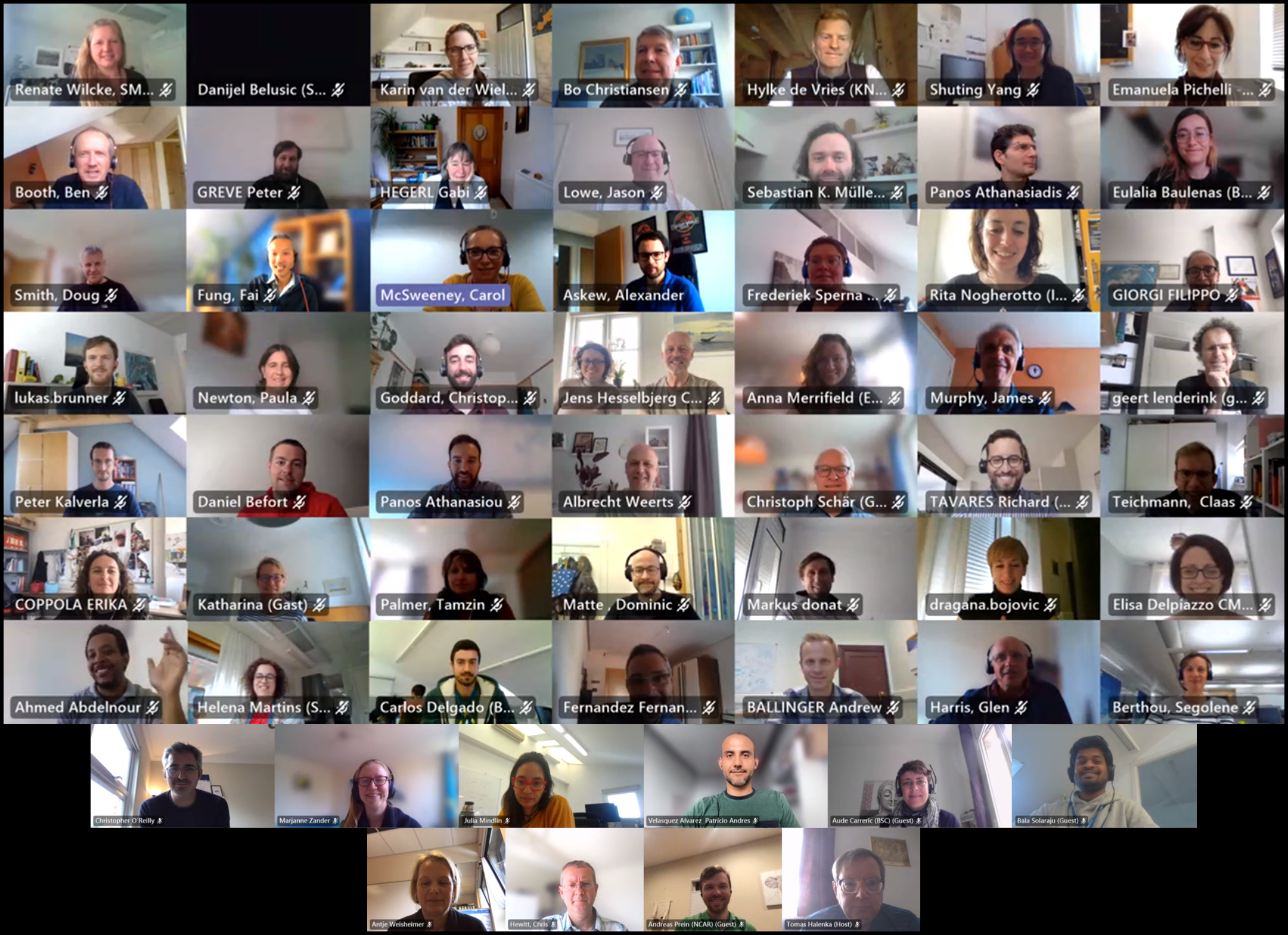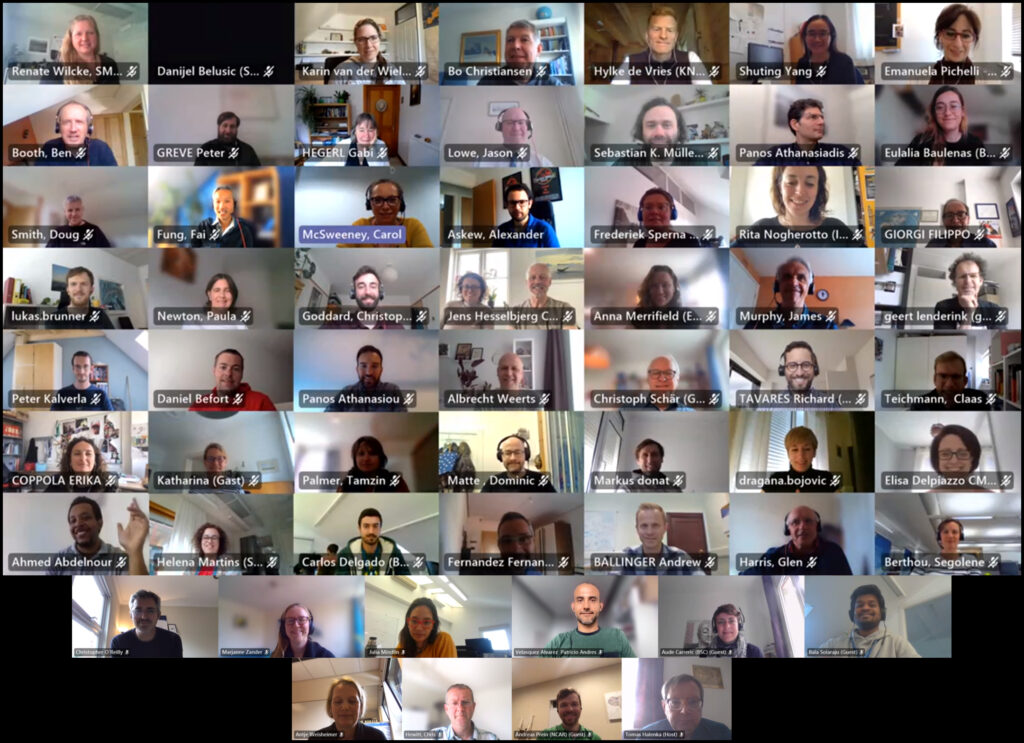The beginning of our third day was dedicated to work from several work packages on convection-permitting climate simulations for Europe and how they can be used. These are made by high-resolution models able to directly simulate atmospheric convection, a key process in many extreme weather events.
The first talk of the day was given by Nikolina Ban, who has been working on a multi-model convection-permitting ensemble over the Greater Alpine region under the CORDEX FPS-CONV project supported by EUCP. This provides better representation of Alpine climate than lower-resolution models and shows differences in its future projections. The frequency of high and extreme rainfall events increases more in the high-resolution models, despite a strong overall drying of the area. Importantly, this study is the first multi-model comparison of convection permitting simulations, offering new information about the robustness and uncertainty of these changes.
We heard from Lizzie Kendon about using these convection-permitting models to simulate future high-impact events, something these models do well. Her team has been working with a Europe-wide 2.2 km scale simulation, run under EUCP. In this simulation they find evidence for a future increase in quasi-stationary, intense rainstorms of the type that caused severe flooding in Western Europe in the summer of 2021. They also found increases in extreme windstorms with damaging sting jets, while other research suggests a decrease in lightning incidence due to changes in ice-based processes in the atmosphere. Possible next steps in this area include more experiments to capture a wider range of uncertainty and identify the drivers of change, as well as much longer simulations across larger areas.
Geert Lenderink told us about the added value available from these high-resolution simulations and how they can be merged with lower-resolution ones at larger scales. Convection-permitting models may not reduce uncertainty but have great benefits for simulating local processes. Short-duration rainfall is a particular strength, but they may have a different signal of future climate change than their higher-resolution counterparts. Importantly, models at different scales all have different strengths and weaknesses, and none may be ideal in all situations. Spatial merging of these model types is important but requires further development.
We then heard more on convection in future winter storms from Ségolène Berthou. Her team have shown an increase in future mean winter precipitation over northern Europe by the end of the century using a convection-permitting model. Looking more closely at this, they demonstrated that precipitation in warm parts of winter storms becomes more like that seen in autumn storms, with more convection than we see today. However, lighter precipitation remains at normal winter levels. This is an important finding, as increased convection in storm systems can reduce their predictability, making it harder to plan for their potential impacts.
Marjanne Zander presented her work on using convection-permitting models to simulate changes in Alpine flood impacts. The new high-resolution simulations of changes in rainfall are applied to models of river discharge and flood impacts. They found the models performed reasonably well at simulating river discharge and captured most significant flood events when simulating historical data. Looking at future projections, they found flood events were set to reduce in frequency in summer, but the extremes would be more severe in intensity. This latter point was also true in the autumn season, though here the frequency is unchanged. Work is ongoing in this area, which promises to provide a great deal of information about these damaging events.
Our final talk of the session was from Hylke de Vries, who presented work EUCP has carried out on some outermost European regions, specifically the Indian Ocean island of La Réunion, the Canary and Madeira archipelagos and the Caribbean. For La Réunion, high-resolution models were shown to perform much better at simulating the island’s topography and the tropical cyclones which sometimes strike it, neither of which a global model could do. For Madeira and the Canaries, the models simulated a tendency towards decreased annual rainfall in the future, though with high variability, while they also proved their ability to simulate the complex wind vortices that form around the islands. In the Caribbean region, mean rainfall is set to decrease, though with an increase in the most extreme rainfall, such as that from hurricanes.
The session’s panel discussion asked the question, “How to get more value from convection-permitting models?” The panellists raised the trade-off between high-resolution and simulation length, as well as how these models allow easier integration with impact modelling, as they are better able to simulate the kinds of factors used in this field. Machine Learning was proposed as a possible answer to the errors introduced by using small-area simulations to economise on computation cost. Pushing towards larger simulations as computational power increases was highlighted as a potential area for progress in this field, though the factors actually desired by climate information users will have to be kept in mind to maintain the models’ value.
Following the panel discussion, we heard an update from Jens Hesselbjerg Christensen on the final meeting of the Multi-User Forum, which took place on the 3rd of May. Follow this link for more on this event.
Our final project meeting ended with a panel discussion of the question, “Where next for European climate prediction?” The scientific progress that has been made in this area is praiseworthy, but more work is needed to make this information more actionable and useful to users. Great advances have been made on constraints and high-resolution modelling, and further work will help make them more applicable to the things climate information users tell us they want. EUCP has highlighted the benefits that co-production between scientists and users can bring, and the panellists were keen to ensure this can continue, especially as the demand for climate information grows. Working to align outputs with those from the Copernicus Climate Change Service and the WMO Lead Centre for Annual-to-Decadal Climate Prediction will help to enhance the usability and value of all these services.
The meeting was closed by Jason Lowe, who once again highlighted the fantastic outputs of EUCP, including the huge number of published papers, the data catalogue and the storyboard platform. This and all the learning from EUCP, including the value of a diverse community of climate scientists working together with climate information users, will go forward for others to build on, moving towards a seamless and actionable European climate prediction system.
See also Part 1 and Part 2 of this report for more on our Final Meeting.





 Funded by the European Union under Horizon 2020.
Funded by the European Union under Horizon 2020.